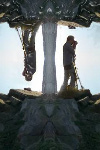© 2020 Iñaki Rezola, All Rights Reserved.
The Virxe da Barca sanctuary has been defying for centuries the fierce winds and gales of the Atlantic ocean in Muxia, on the Galician Costa da Morte ("Death Coast" in English). For some pilgrims to Santiago de Compostela, this is the real final destination.
The sanctuary owes it's name to an old tradition from the Middle Ages according to which the Virgin Mary sailed on a stone boat to Galicia in order to comfort the apostle James, who was there preaching the new belief.
But long before being a Christian sanctuary, this was already a Celtic sacred location, probably due to the presence here of several rocking stones, or "pedras de abalar".
These are large granite stones, naturally so well balanced and equilibrated by the effect of erosion that they can be easily made to move and some even oscillate and rock by themselves when the wind blows. This has often made them object to all kinds of superstitions and people would perform there a variety of rituals in order most of the times to recover their health or ask for their wishes to be fulfilled.
The rocking stones near the sanctuary of Muxia were not an exception, and there was even the conviction that they were the hull and sails of the boat on which the Virgin Mary arrived to this shores.
With an enlarging amount of people who love to believe themselves back on a flat planet, will we ever be transported to a time when this huge granite pieces will sail again off the dangerous coast of the Costa da Morte?
Lat: 43° 6' 43.924" N
Long: 10° 14' 13.526" W
Precision is: Medium. Nearby, but not to the last decimal.
Nikon D800, Nikkor 16mm, monopod, self-made panohead, PTGui Pro, PS.



 Tap or click the zoom icon in the bottom right corner of the picture to switch between in-page and fullscreen view
Tap or click the zoom icon in the bottom right corner of the picture to switch between in-page and fullscreen view